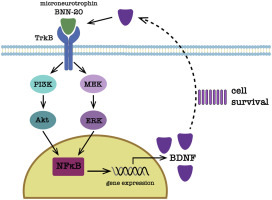当前位置:
X-MOL 学术
›
Neuropharmacology
›
论文详情
Our official English website, www.x-mol.net, welcomes your
feedback! (Note: you will need to create a separate account there.)
Anti-neuroinflammatory, protective effects of the synthetic microneurotrophin BNN-20 in the advanced dopaminergic neurodegeneration of "weaver" mice.
Neuropharmacology ( IF 4.6 ) Pub Date : 2019-12-23 , DOI: 10.1016/j.neuropharm.2019.107919 Vasiliki Panagiotakopoulou 1 , Konstantinos Botsakis 2 , Foteini Delis 3 , Theodora Mourtzi 1 , Manolis N Tzatzarakis 4 , Aggeliki Dimopoulou 2 , Nafsika Poulia 3 , Katerina Antoniou 3 , Georgios T Stathopoulos 2 , Nikolaos Matsokis 1 , Ioannis Charalampopoulos 5 , Achilleas Gravanis 5 , Fevronia Angelatou 2
Neuropharmacology ( IF 4.6 ) Pub Date : 2019-12-23 , DOI: 10.1016/j.neuropharm.2019.107919 Vasiliki Panagiotakopoulou 1 , Konstantinos Botsakis 2 , Foteini Delis 3 , Theodora Mourtzi 1 , Manolis N Tzatzarakis 4 , Aggeliki Dimopoulou 2 , Nafsika Poulia 3 , Katerina Antoniou 3 , Georgios T Stathopoulos 2 , Nikolaos Matsokis 1 , Ioannis Charalampopoulos 5 , Achilleas Gravanis 5 , Fevronia Angelatou 2
Affiliation

|
BNN-20 is a synthetic microneurotrophin, long-term (P1-P21) administration of which exerts potent neuroprotective effect on the "weaver" mouse, a genetic model of progressive, nigrostriatal dopaminergic degeneration. The present study complements and expands our previous work, providing evidence that BNN-20 fully protects the dopaminergic neurons even when administration begins at a late stage of dopaminergic degeneration (>40%). Since neuroinflammation plays a critical role in Parkinson's disease, we investigated the possible anti-neuroinflammatory mechanisms underlying the pharmacological action of BNN-20. The latter was shown to be microglia-mediated, at least in part. Indeed, BNN-20 induced a partial, but significant, reversal of microglia hyperactivation, observed in the untreated "weaver" mouse. Furthermore, it induced a shift in microglia polarization towards the neuroprotective M2 phenotype, suggesting a possible beneficial shifting of microglia activity. This observation was further supported by morphometric measurements. Moreover, BDNF levels, which were severely reduced in the "weaver" mouse midbrain, were restored to normal even after short-term BNN-20 administration. Experiments in "weaver"/NGL (dual GFP/luciferase-NF-κВ reporter) mice using bioluminescence after a short BNN-20 treatment (P60-P74), have shown that the increase of BDNF production was specifically mediated through the TrkB-PI3K-Akt-NF-κB signaling pathway. Interestingly, long-term BNN-20 treatment (P14-P60) significantly increased dopamine levels in the "weaver" striatum, which seems to be associated with the improved motor activity observed in the treated mutant animals. In conclusion, our findings suggest that BNN-20 may serve as a lead molecule for new therapeutic compounds for Parkinson's disease, combining strong anti-neuroinflammatory and neuroprotective properties, leading to elevated dopamine levels and improved motor activity.
中文翻译:

合成的微神经营养蛋白BNN-20在“织布工”小鼠晚期多巴胺能神经退行性变中的抗神经炎,保护作用。
BNN-20是一种合成的微神经营养蛋白,长期服用(P1-P21),可对“织布工”小鼠产生有效的神经保护作用,“织布工”小鼠是进行性黑质纹状体多巴胺能变性的遗传模型。本研究补充并扩展了我们以前的工作,提供了证据,即使在多巴胺能变性的晚期(> 40%)开始给药时,BNN-20仍能完全保护多巴胺能神经元。由于神经炎症在帕金森氏病中起关键作用,因此我们研究了BNN-20药理作用下可能的抗神经炎机制。后者至少部分是由小胶质细胞介导的。实际上,在未经治疗的“编织者”小鼠中观察到,BNN-20诱导了小胶质细胞过度活化的部分但重要的逆转。此外,它诱导了小胶质细胞极化向神经保护性M2表型的转变,提示小胶质细胞活性可能发生了有益的转变。形态计量学测量进一步支持了该观察。此外,即使在短期施用BNN-20后,在“编织者”小鼠中脑中严重降低的BDNF水平也恢复到正常水平。在短暂的BNN-20处理(P60-P74)后使用生物发光的“编织者” / NGL(双GFP /荧光素酶-NF-κ记者)小鼠中的实验表明,BDNF产生的增加是通过TrkB-PI3K特异性介导的-Akt-NF-κB信号通路。有趣的是,长期的BNN-20治疗(P14-P60)会显着增加“编织者”纹状体中的多巴胺水平,这似乎与在治疗的突变动物中观察到的运动活性改善有关。总之,我们的发现表明,BNN-20可能是帕金森氏病新治疗化合物的先导分子,结合了强大的抗神经炎和神经保护特性,导致多巴胺水平升高和运动活动改善。
更新日期:2019-12-23
中文翻译:

合成的微神经营养蛋白BNN-20在“织布工”小鼠晚期多巴胺能神经退行性变中的抗神经炎,保护作用。
BNN-20是一种合成的微神经营养蛋白,长期服用(P1-P21),可对“织布工”小鼠产生有效的神经保护作用,“织布工”小鼠是进行性黑质纹状体多巴胺能变性的遗传模型。本研究补充并扩展了我们以前的工作,提供了证据,即使在多巴胺能变性的晚期(> 40%)开始给药时,BNN-20仍能完全保护多巴胺能神经元。由于神经炎症在帕金森氏病中起关键作用,因此我们研究了BNN-20药理作用下可能的抗神经炎机制。后者至少部分是由小胶质细胞介导的。实际上,在未经治疗的“编织者”小鼠中观察到,BNN-20诱导了小胶质细胞过度活化的部分但重要的逆转。此外,它诱导了小胶质细胞极化向神经保护性M2表型的转变,提示小胶质细胞活性可能发生了有益的转变。形态计量学测量进一步支持了该观察。此外,即使在短期施用BNN-20后,在“编织者”小鼠中脑中严重降低的BDNF水平也恢复到正常水平。在短暂的BNN-20处理(P60-P74)后使用生物发光的“编织者” / NGL(双GFP /荧光素酶-NF-κ记者)小鼠中的实验表明,BDNF产生的增加是通过TrkB-PI3K特异性介导的-Akt-NF-κB信号通路。有趣的是,长期的BNN-20治疗(P14-P60)会显着增加“编织者”纹状体中的多巴胺水平,这似乎与在治疗的突变动物中观察到的运动活性改善有关。总之,我们的发现表明,BNN-20可能是帕金森氏病新治疗化合物的先导分子,结合了强大的抗神经炎和神经保护特性,导致多巴胺水平升高和运动活动改善。











































 京公网安备 11010802027423号
京公网安备 11010802027423号